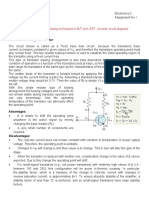0 ratings0% found this document useful (0 votes)
12 viewsEDC Course Lect 11-15
EDC Course Lect 11-15
Uploaded by
Harsh DeshwalThis document discusses biasing schemes for BJTs. It explains that biasing involves connecting DC sources and resistors to set an operating point in the active region. Three common biasing modes are described: fixed/base bias, emitter feedback bias, and voltage divider bias. Emitter feedback bias provides better stability against temperature and transistor variability changes. The document also covers load lines, operating points, bias stability factors, and using BJTs as amplifiers and switches in circuits.
Copyright:
© All Rights Reserved
Available Formats
Download as PDF, TXT or read online from Scribd
EDC Course Lect 11-15
EDC Course Lect 11-15
Uploaded by
Harsh Deshwal0 ratings0% found this document useful (0 votes)
12 views27 pagesThis document discusses biasing schemes for BJTs. It explains that biasing involves connecting DC sources and resistors to set an operating point in the active region. Three common biasing modes are described: fixed/base bias, emitter feedback bias, and voltage divider bias. Emitter feedback bias provides better stability against temperature and transistor variability changes. The document also covers load lines, operating points, bias stability factors, and using BJTs as amplifiers and switches in circuits.
Original Description:
Electronic Devices and Circuits
Copyright
© © All Rights Reserved
Available Formats
PDF, TXT or read online from Scribd
Share this document
Did you find this document useful?
Is this content inappropriate?
This document discusses biasing schemes for BJTs. It explains that biasing involves connecting DC sources and resistors to set an operating point in the active region. Three common biasing modes are described: fixed/base bias, emitter feedback bias, and voltage divider bias. Emitter feedback bias provides better stability against temperature and transistor variability changes. The document also covers load lines, operating points, bias stability factors, and using BJTs as amplifiers and switches in circuits.
Copyright:
© All Rights Reserved
Available Formats
Download as PDF, TXT or read online from Scribd
Download as pdf or txt
0 ratings0% found this document useful (0 votes)
12 views27 pagesEDC Course Lect 11-15
EDC Course Lect 11-15
Uploaded by
Harsh DeshwalThis document discusses biasing schemes for BJTs. It explains that biasing involves connecting DC sources and resistors to set an operating point in the active region. Three common biasing modes are described: fixed/base bias, emitter feedback bias, and voltage divider bias. Emitter feedback bias provides better stability against temperature and transistor variability changes. The document also covers load lines, operating points, bias stability factors, and using BJTs as amplifiers and switches in circuits.
Copyright:
© All Rights Reserved
Available Formats
Download as PDF, TXT or read online from Scribd
Download as pdf or txt
You are on page 1of 27
Biasing Scheme for BJT – Lecture 11
• Biasing is the process of connecting DC sources
of proper magnitude in correct polarity along
with suitable magnitude of Resistances so that
the Transistor Circuit can work in Active region
as Amplifier satisfactorily.
• This is known as DC Biasing. With DC biasing we
determine an operating point (or Q-Point) in
such a way that it lies in the middle of the
active region such that for all the variations of
AC input signal it should remain in active region
and not driven to cut-off or saturation.
Biasing scheme for 3 different Operating Modes
• The input output terminals and the polarity of
the DC biases on the input and output sides
for the 3 different modes of operation are as
shown in the figure above
Problems with Biasing of BJT
• There are two inherent difficulties with BJT:
1. The β of two different transistors (of same specification
but) produced in two different batches is not same and
varies considerably. For example as per the data sheet of
2N3904 the β may vary from 100 to 300 at 25°C.
2. The β of a transistor varies significantly with temperature
i.e. it increases with increase in temperature.
Due to these two factors the Q-Point doesn’t remain fixed.
This change in Q-Point results in unfaithful amplification
operation of the BJT. Hence, we have been forced to
develop such biasing schemes which can stabilize the
operating point as far as possible with the change in
temperature or with the replacement of transistor.
Phenomena of Thermal Runway in BJT
• In order to avoid this phenomena of Thermal Runway
and to achieve stabilization of operating point we need
to provide some type of feedback mechanism in the
biasing. This results in different biasing techniques as
described later.
Determination of Operating Point – Lecture 12
• In order to achieve faithful operation of
Transistor as an Amplifier we first bias it with DC
sources suitably and find a particular operating
point of output voltage and current (VCE and IC).
• Then we apply the input AC signal at this
operating point such that the variation in input
signal is amplified and produced as a variation
in the operating point voltage and current.
• The operating point is chosen in such a way that
for all the points of input AC variation the
transistor must remain in active region.
BJT: Load Line
• The load line is a straight line which comprises
of all the points of output voltage and current
(VCE and IC) corresponding to the variation in
input signal
BJT: Load Line
• The KVL in the output loop gives the equation
of the load line and the 2 extreme end points
are evaluated to draw the load line as shown
BJT: DC & AC load line and Q-point
BJT: DC & AC load line and Q-point
• The DC load line comprises of the points of output
side corresponding to the variation in DC bias of
input side, whereas the AC load line comprises of
the points of the output side corresponding to the
variation in AC signal at the input side.
• The AC load line has a steeper slope as compared
to the DC load line as the equivalent resistance in
case of AC is lower than in case of DC.
• The 2 load lines intersect at the operating point
known as (Q-point)
Numerical
Bias Stability & Bias Stabilization – Lecture 14
• As explained earlier the Transistor Operating
Point gets destabilized due to change in
temperature or replacement of transistor.
• However, for the faithful working as an amplifier
it is desirable that the operating point should
remain stable.
• The stability of the bias is measured as stability
factor the ratio of change in collector current IC to
the change in leakage current ICBO or ICO.
• It is desirable that the stability factor should be as
small as possible as explained later.
Different Biasing Techniques – Lecture 13
1. Base Bias or Fixed Bias:
2. Emitter Feedback Bias
2. Emitter Feedback Bias
• It is clearly observed that Emitter feedback
bias results in better bias stabilization if
• RE >> RB and RE >> RB/ β
Numerical Emitter Feedback Bias
3. Collector Feedback Bias
4. Voltage Divider Bias or Self Bias
Numerical Voltage Divider Bias
UNIT – III
Practical Applications of BJT
• BJT as an Amplifier and as a Switch – Lecture 15
BJT: As an Amplifier
• In CE mode the BJT acts as an amplifier in the
active region
BJT: As a Switch
• Here output takes only 2 values Vcc or 0
(corresponding to logic 1 & 0) when the transistor is
driven to cutoff and saturation states respectively
Numerical
You might also like
- DigiTRON July 2013 PDFDocument60 pagesDigiTRON July 2013 PDFZhiyong ShanNo ratings yet
- Pspice MosfetsDocument6 pagesPspice Mosfetsbhaskar1210510101No ratings yet
- Electronic Circuits IDocument222 pagesElectronic Circuits ISATYA MOORTHYNo ratings yet
- ECD Skill-Based-Mini-Project (1) - RemovedDocument12 pagesECD Skill-Based-Mini-Project (1) - RemovedAyushi singh PariharNo ratings yet
- EDC Course Lect 6 - 10Document31 pagesEDC Course Lect 6 - 10Harsh DeshwalNo ratings yet
- EC2205 QBDocument31 pagesEC2205 QBRaji SharmiNo ratings yet
- Word Bipolar TransistorDocument9 pagesWord Bipolar TransistorAliza TariqNo ratings yet
- BJTDocument30 pagesBJTSwarna AshokNo ratings yet
- Module - 2 ADC NotesDocument27 pagesModule - 2 ADC Notesblackhole9529No ratings yet
- Ca2 - Ec 402Document7 pagesCa2 - Ec 402Movie KingNo ratings yet
- BJT Circuits - Basic Electronics GuideDocument55 pagesBJT Circuits - Basic Electronics GuideNenad Stamenović100% (1)
- DC BiasingDocument9 pagesDC BiasingnagarajNo ratings yet
- AnalogElectronics - TH 1 BJTDocument20 pagesAnalogElectronics - TH 1 BJTAlbert GenceNo ratings yet
- Bipolar-Junction Transistor: Mrinmoy Kundu, Lecturer Dept. of EEE, BUET Date: 4/2/2024Document22 pagesBipolar-Junction Transistor: Mrinmoy Kundu, Lecturer Dept. of EEE, BUET Date: 4/2/2024Tasnim TishaNo ratings yet
- Transistor Biasing and StabilisationDocument22 pagesTransistor Biasing and StabilisationAnshika WaliaNo ratings yet
- Unit I: Power Supplies and Biasing of Discrete BJT and MosfetDocument6 pagesUnit I: Power Supplies and Biasing of Discrete BJT and MosfetAlwynNo ratings yet
- EC6304 Uw PDFDocument119 pagesEC6304 Uw PDFsivadhanuNo ratings yet
- ADEC - Lab 3Document14 pagesADEC - Lab 3syed furqan javedNo ratings yet
- Edc Unit 4Document26 pagesEdc Unit 4raghulNo ratings yet
- Transistor Biasing - Notes 5Document5 pagesTransistor Biasing - Notes 5En En BelthereNo ratings yet
- 18CSS201J Analog and Digital ElectronicsDocument34 pages18CSS201J Analog and Digital ElectronicsPriyansh GuptaNo ratings yet
- Transistor Biasing and StabilisationDocument22 pagesTransistor Biasing and StabilisationRaja Sekhar BatchuNo ratings yet
- 09 ExperimentDocument4 pages09 ExperimentMuhammad AsifNo ratings yet
- Karakteristik BJTDocument35 pagesKarakteristik BJTKrisna Adji SyahputraNo ratings yet
- Analog Electronic CircuitsDocument67 pagesAnalog Electronic Circuitsajas777BNo ratings yet
- EC6304 Notes PDFDocument119 pagesEC6304 Notes PDFpandiyarajan142611No ratings yet
- Unit 2Document46 pagesUnit 2Manan JainNo ratings yet
- Unit 6. Introduction To Bi-Polar Junction Transistor (BJT)Document9 pagesUnit 6. Introduction To Bi-Polar Junction Transistor (BJT)Gunjan GuptaNo ratings yet
- Ch.5 Transistor BiasingDocument19 pagesCh.5 Transistor Biasingdes tosNo ratings yet
- BJT AS AmplifierDocument6 pagesBJT AS AmplifierMuhammad AsifNo ratings yet
- Ie 51Document51 pagesIe 51Ananya ChavanNo ratings yet
- Bipolar Transistor Biasing PDFDocument11 pagesBipolar Transistor Biasing PDFAliza TariqNo ratings yet
- 216 - EC8351, EC6304 Electronic Circuits I - Notes 1Document119 pages216 - EC8351, EC6304 Electronic Circuits I - Notes 1Rani VijayNo ratings yet
- Mod 1Document110 pagesMod 1somus3971No ratings yet
- Unit Ibiasing of Discrete BJT and MosfetDocument57 pagesUnit Ibiasing of Discrete BJT and MosfetVijayakumar SNo ratings yet
- Term 2, Lecture 4: Transistor Bias Circuits The DC Operating PointDocument7 pagesTerm 2, Lecture 4: Transistor Bias Circuits The DC Operating Pointrafal mahmodNo ratings yet
- EDC - Unit 3 FinalDocument118 pagesEDC - Unit 3 FinalDr UmapathyNo ratings yet
- Experiment No. 6 & 7: Transistor As (I) An Amplifier and (Ii) As A Switch Pre Lab Task ObjectivesDocument6 pagesExperiment No. 6 & 7: Transistor As (I) An Amplifier and (Ii) As A Switch Pre Lab Task ObjectivesDaniyaal ShibliNo ratings yet
- Ec I (16 M) - Unit IDocument19 pagesEc I (16 M) - Unit IGtecEceNo ratings yet
- EC6304 Electronic Circuits I Question BankDocument10 pagesEC6304 Electronic Circuits I Question BankAnonymous kQZgP8No ratings yet
- BJT Biasing and StabilizationDocument8 pagesBJT Biasing and StabilizationNehemiah LemombianNo ratings yet
- AbcDocument8 pagesAbcFasil TareNo ratings yet
- CE ConfigurationsDocument20 pagesCE ConfigurationsLawrence RamosNo ratings yet
- Bipolar Junction Transistors (BJT)Document36 pagesBipolar Junction Transistors (BJT)Anuj KhannaNo ratings yet
- Unit 3Document30 pagesUnit 3[C3B] Aqilah HusnaNo ratings yet
- 8 - Bipolar Junction TransistorDocument38 pages8 - Bipolar Junction TransistorShahnail MemonNo ratings yet
- Bipolar Junction Transistor - M4Document24 pagesBipolar Junction Transistor - M4RickyNo ratings yet
- Stability FactorDocument18 pagesStability FactorPushkin SaxenaNo ratings yet
- Bipolar Transistor BiasingDocument8 pagesBipolar Transistor BiasingGilberto ManhattanNo ratings yet
- 1.1 Introduction To Buck ConverterDocument44 pages1.1 Introduction To Buck Converterapi-19810277No ratings yet
- Bipolar Junction Transistor (BJT)Document57 pagesBipolar Junction Transistor (BJT)Tooba AkhtarNo ratings yet
- BJT 1Document36 pagesBJT 1Divina JaneNo ratings yet
- Analysis of BJT AmplrDocument3 pagesAnalysis of BJT AmplrMalikAlrahabiNo ratings yet
- Analysis of BJT AmplrDocument3 pagesAnalysis of BJT AmplrAnchita HaldarNo ratings yet
- Analysis of BJT AmplrDocument3 pagesAnalysis of BJT AmplrAnkit KumarNo ratings yet
- Duarte ECE005 Assignment No.1 PrelimDocument5 pagesDuarte ECE005 Assignment No.1 PrelimJohn Paul DirayNo ratings yet
- Chap 4 DC Biasing BJTDocument44 pagesChap 4 DC Biasing BJTUgeswran ThamalinggamNo ratings yet
- Analog Lab ManualDocument57 pagesAnalog Lab ManualMukesh Sahu100% (1)
- EC2205 QBDocument24 pagesEC2205 QBjeevaNo ratings yet
- 3.bipolar Junction Transistor (BJT)Document44 pages3.bipolar Junction Transistor (BJT)luis_sergio_barrosNo ratings yet
- Reference Guide To Useful Electronic Circuits And Circuit Design Techniques - Part 2From EverandReference Guide To Useful Electronic Circuits And Circuit Design Techniques - Part 2No ratings yet
- Reference Guide To Useful Electronic Circuits And Circuit Design Techniques - Part 1From EverandReference Guide To Useful Electronic Circuits And Circuit Design Techniques - Part 1Rating: 2.5 out of 5 stars2.5/5 (3)
- Balanced Three Phase SystemDocument16 pagesBalanced Three Phase SystemPao Castillon100% (1)
- Besck104c 204c Iec Module5 NotesDocument26 pagesBesck104c 204c Iec Module5 NotesFaiz Karobari100% (1)
- IES 2011 Objective Paper 1 ElectricalDocument24 pagesIES 2011 Objective Paper 1 Electricalsandeep3646No ratings yet
- AL600ACM220: Access Power Controller With Power Supplies Installation GuideDocument8 pagesAL600ACM220: Access Power Controller With Power Supplies Installation GuideUsman ZouqueNo ratings yet
- VIT Power Electronics and Drives Syllabus 2012Document18 pagesVIT Power Electronics and Drives Syllabus 2012LinuNo ratings yet
- Coupler - Spliter - AntenDocument5 pagesCoupler - Spliter - AntentheanhcbNo ratings yet
- MSC Sense Course Description Tue 2019 2020Document3 pagesMSC Sense Course Description Tue 2019 2020TalhaNo ratings yet
- Manual Servico PT-LB20SUDocument75 pagesManual Servico PT-LB20SUjocimar1000No ratings yet
- ECEg 7411 Lecture 2 Power Electronics For Inverter DesignDocument15 pagesECEg 7411 Lecture 2 Power Electronics For Inverter Designbisrat yeshidagnaNo ratings yet
- TH Series by Proline - Liner Heat Detection - HADocument1 pageTH Series by Proline - Liner Heat Detection - HAphucetau zNo ratings yet
- Required Capacitor Banks Sizing Calculation PDFDocument2 pagesRequired Capacitor Banks Sizing Calculation PDFAZAMNo ratings yet
- 11 VSD& Harmonics PDFDocument100 pages11 VSD& Harmonics PDFsiruslara6491No ratings yet
- Ray Optics and Optical InstrumentsDocument27 pagesRay Optics and Optical InstrumentsSachin100% (1)
- 02-Structure of AtomDocument2 pages02-Structure of AtomPriyanshNo ratings yet
- Digital Multifunction Instrument: ApplicationDocument7 pagesDigital Multifunction Instrument: ApplicationNihar RoyNo ratings yet
- Copper UltrasilDocument16 pagesCopper UltrasilTejo WahonoNo ratings yet
- Lz100 Ac Servo Easy Manual 2022Document104 pagesLz100 Ac Servo Easy Manual 2022VN MÁY TỰ ĐỘNGNo ratings yet
- 1-S-Quantum EspressoDocument6 pages1-S-Quantum EspressoAbir SoujaaNo ratings yet
- Project ReportDocument19 pagesProject ReportAriel FariasNo ratings yet
- Century L100 - Caixa de Som Clássica Da JBLDocument20 pagesCentury L100 - Caixa de Som Clássica Da JBLdermevalNo ratings yet
- Electromagnetic Wave TheoryDocument31 pagesElectromagnetic Wave TheoryJasperjames BaldevizoNo ratings yet
- AbstractDocument5 pagesAbstractابو علي الحيدريNo ratings yet
- DC Biasing - BJTS: Base Bias (Fixed Bias) Voltage Divider Bias Collector-Feedback Bias Emitter-Feedback BiasDocument43 pagesDC Biasing - BJTS: Base Bias (Fixed Bias) Voltage Divider Bias Collector-Feedback Bias Emitter-Feedback BiasĐức TrầnNo ratings yet
- Infineon 8CLJQ045 DataSheet v01 - 01 ENDocument5 pagesInfineon 8CLJQ045 DataSheet v01 - 01 ENjulio cardosoNo ratings yet
- 6 Factors Influencing Requirements For A Good Grounding SystemDocument4 pages6 Factors Influencing Requirements For A Good Grounding SystemJojo ManzanoNo ratings yet
- 32L2433D (G) 32L2453D (G) : (Model Information)Document51 pages32L2433D (G) 32L2453D (G) : (Model Information)jacks uaeNo ratings yet
- 19ELE35 QUIZ 3C Quiz 2Document1 page19ELE35 QUIZ 3C Quiz 2avinash_yuvarajNo ratings yet
- Master Trip Relay (86) Concept in Power System Explained in DetailDocument2 pagesMaster Trip Relay (86) Concept in Power System Explained in DetailAbdul Mohid SheikhNo ratings yet

























































































